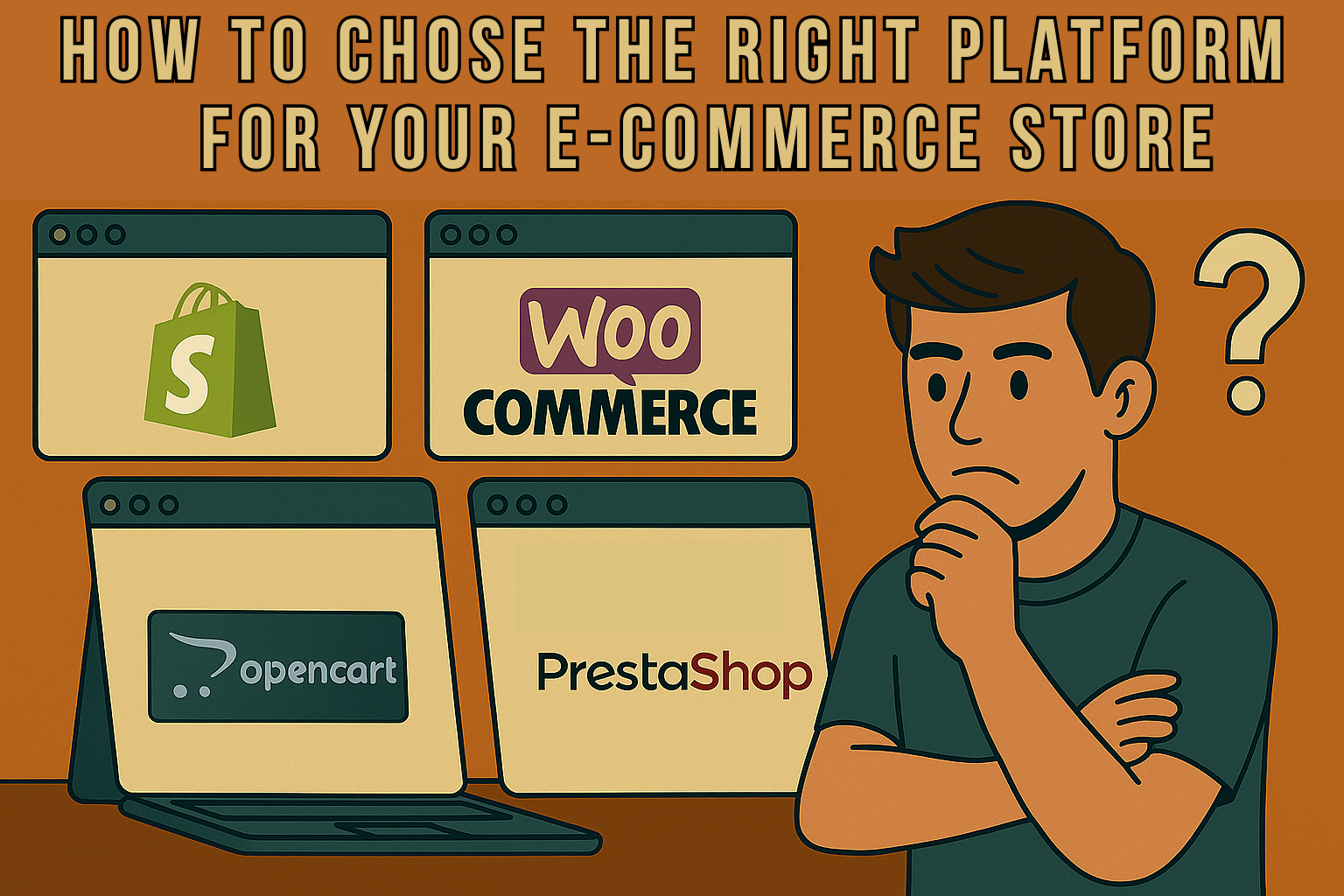If you’re reading this, you probably have an online store idea fluttering in your mind, maybe you’re selling handmade candles, custom T-shirts, or high-tech gadgets. Great! But before you dive headfirst into product photos and packaging tape, there’s a crucial decision to make: choosing the right e-commerce platform. Picking the wrong one is like buying a Lamborghini when you only know how to drive a bicycle. Well, you could do it, but it’s going to cost you time, frustration and maybe tears.
In 2025, the landscape of online store builders is richer (and trickier) than ever. There are giants like Shopify, flexible power-users tools like WooCommerce, and open-source adventures like OpenCart and PrestaShop. Each claims to be “the best e-commerce platform 2025” option but “best” depends a lot on you (your budget, your skill level, your growth goals). I’m going to walk you through what to look for, compare costs (hello Shopify vs WooCommerce cost 2025), and put OpenCart vs PrestaShop vs WooCommerce in the ring. By the end you should feel sane and confident.
What does “Best E-commerce Platform” Really Mean?
When you Google “best e-commerce platform 2025”, you’ll find many lists, reviews and ranking sites. For example, Shopify’s blog lists the “11 best e-commerce platforms for 2025” and helps you pick based on business size, features or growth stage. Another summary from G2 mentions leaders like Shopify, WooCommerce and BigCommerce based on usability and features.
But a key piece to remember: the “best” platform for me might not be the “best” for you. What matters are things like:
- Scalability: Will the platform grow with you if you go from 100 to 10,000 products?
- Cost and budget: Monthly fee + transaction fees + add-ons.
- Technical comfort: Are you comfortable with hosting, updates and code?
- SEO & marketing support: Can you easily rank in search engines, integrate marketing tools, etc?
- Ecosystem and support: Are there themes, apps, plugins, support communities?
So your first step is to define your priorities: budget vs speed vs flexibility vs control.
Key Criteria to Evaluate Your E-commerce platform
Let’s break down some of the most important criteria you should weigh (and yes, you can totally sip a coffee while doing this).
Cost and Pricing Model
What you’ll pay includes: monthly or annual fees, transaction fees, hosting (if self-hosted), theme or plugin costs, and maybe developer costs. For example:
- Shopify’s pricing starts at a fixed monthly plan plus transaction fees if you don’t use Shopify Payments.
- WooCommerce itself is free as a plugin, but you’ll pay for hosting, domain, SSL, plugins, maybe themes.
Ease of Use / Speed to Market
If you want to launch fast and don’t want to wrestle with servers, go with something that handles hosting and setup for you. Shopify is strong here. If you’re comfortable with WordPress or self-hosting, WooCommerce offers more flexibility but more responsibility.
Customization & Flexibility
If you dream of a unique design or weird product types (subscriptions, bundles, digital + physical mix), you’ll want a platform that allows extensions, custom coding or plugins. Open source & WordPress win on flexibility; hosted thrives on simplicity.
Scalability & Performance
If you expect your store to grow big (lots of traffic, lots of SKUs, global customers), you’ll want a platform that can handle load, caching, multi-currency/language support, etc.
SEO, Marketing & Integrations
You want your store to be found. That means clean URLs, meta tags, mobile-friendly, fast loading, good user experience. Platforms that integrate easily with marketing tools and plugins are big advantages.
Support, Community & Longevity
Make sure the platform is actively maintained, has security updates, a healthy community, and good support. A big red flag: platform abandoned or plugins unsupported.
Shopify vs WooCommerce

Let’s face it, cost is a huge deal. Let’s compare the two big names: Shopify and WooCommerce (on WordPress).
Shopify
- Starting plan around US $19/month (basic at time of writing) + normal payment processing fees.
- If you use external payment gateways (not Shopify Payments) you may face extra transaction fees.
- Because hosting, security, updates etc are handled for you, less technical overhead.
- But if you add many apps or need custom functionality, costs can go up quickly.
WooCommerce
- The core WooCommerce plugin is free.
- But you’ll need hosting (which might cost a few dollars per month depending on traffic), domain, SSL certificate, themes and plugin costs.
- Payment processing fees still apply; WooPayments plugin charges similar rates to Shopify for card payments (2.9% + US$0.30) in some regions.
- You have full control (which means you must handle updates, security, backups).
- If your store is large, or you need customizations, developer costs may be relevant.
Which is cheaper?
- For a small store with moderate traffic, Shopify’s predictable monthly cost might be simpler and even cheaper (especially when you value convenience).
- For someone comfortable managing hosting, or someone who already has a WordPress site, WooCommerce may be lower cost in the long run especially if you avoid a lot of paid add-ons.
- Several 2025 analyses suggest: WooCommerce wins on flexibility/cost if you’re willing to do the work; Shopify wins on ease and predictability.
My take
If I were you: if you’re non-tech or want to launch fast, pick Shopify; if you’re comfortable with WordPress, want content marketing + e-commerce, and want full control, go WooCommerce. Always factor real costs (plugins, maintenance, transaction fees) rather than just entry price.
OpenCart vs PrestaShop vs WooCommerce Comparison
Now for some open-source heavyweights: OpenCart, PrestaShop and WooCommerce. If you’re thinking “I want full control”, this is your ring.
Quick overview
- OpenCart: Open-source, relatively lightweight, good for small to medium stores with technical comfort.
- PrestaShop: Also open-source, more feature-rich out-of-the-box, good for medium sized stores or those that plan to grow internationally.
- WooCommerce: Plugin for WordPress, extremely flexible, massive ecosystem. But needs hosting, more setup.
Ease of Use
- OpenCart tends to be “simpler” for basic stores, but still requires hosting and some familiarity with tech.
- PrestaShop offers more built-in features, which might mean a steeper learning curve.
- WooCommerce is easiest for WordPress users: if you already know WP you’ll feel at home.
Cost & Hosting
All three are “free” at the core, no monthly license fees, but you must pay for hosting, domain, SSL, and paid modules/plugins/themes. For instance: “OpenCart vs WooCommerce” analysis shows comparable costs in many cases, but WooCommerce might require more work.
Customization & Ecosystem
- WooCommerce: huge plugin ecosystem because of WordPress.
- PrestaShop: good modules and themes, good for localization (multiple languages, currencies).
- OpenCart: decent, but fewer mainstream themes/plugins than WooCommerce.
SEO & Marketing
- WooCommerce wins here if you pair with good SEO plugins (since it benefits from WordPress). For example, one article says: “WooCommerce offers greater flexibility, user-friendliness and SEO advantages compared to OpenCart.”
- PrestaShop also has decent marketing modules built in.
- OpenCart doesn’t shine as much in out-of-the-box SEO compared to the others.
Scalability & Performance
- PrestaShop and WooCommerce are better suited for larger product catalogs or stores that plan to scale.
- OpenCart might be adequate for smaller operations or limited SKUs.
My Recommendation
- If you’re building a modest store, self-hosting, want low cost, minimal frills: OpenCart could work.
- If you expect growth, want localization, more built-in features: PrestaShop.
- If you already use WordPress, want content + commerce, want max flexibility: WooCommerce.

How to Make the Right Decision
Here’s a simple breakdown (no fancy chart, I know we like simple).
How technical are you or willing to be?
- Not technical / want minimal fuss → SaaS like Shopify.
- Comfortable with hosting, plugins, WordPress → WooCommerce or open-source.
What’s your budget & expected sales volume?
- Small startup, limited budget → minimize monthly fees, simple store.
- Growth expected, larger catalog → you’ll need scalability, plan for it.
How unique are your requirements (design, product types, international)?
- Standard store, physical products, simple workflow → any will work.
- Complex combos, custom checkout, many languages/currencies → favour open-source more flexible platforms.
How important is SEO, content marketing, brand story?
- If you plan heavy content marketing and blogging → WooCommerce (WordPress) is attractive.
- If you just want a fast selling channel → Shopify or simpler open-source may suffice.
What’s your long-term plan?
- Plan to expand, change, scale globally → pick a platform that won’t box you in.
- If you’re testing an idea and may pivot → maybe go with simpler / lower cost to start.
A Few Extra Thoughts
- Even the best platform cannot replace good product photos, strong branding, and customer service. You could pick the “perfect” platform, but if your checkout is confusing or shipping takes forever, you’ll lose sales.
- Hosting matters: if you’re self-hosting (WooCommerce, OpenCart, PrestaShop) choose a fast, reliable host. A slow store kills conversions and SEO.
- Don’t forget mobile: Many users will shop on smartphones, so your store must perform well mobile-first.
- Backup & security: If self-hosted, you are responsible. Even SaaS platforms can face issues, so ensure you have a plan for data.
- Migration cost: If you outgrow your platform, migrating can cost time and money. Try to pick one with decent flexibility to avoid big headaches later.
Conclusion
Choosing the right platform for your e-commerce store in 2025 isn’t just about picking the most “popular” or “highest rated” tool. It’s about aligning the platform with your specific needs like budget, skill, growth plans and how much control you want. If you want a fast launch, minimal setup, and are okay with paying for convenience, go with Shopify. If you want content marketing + commerce, love WordPress, and want full control, WooCommerce is compelling. If you’re looking for open-source customization, have technical ability or access to it, then OpenCart or PrestaShop deserve serious consideration.
By carefully evaluating costs, ease-of-use, flexibility, scalability, SEO strengths and support ecosystem, you’ll be in a strong position to pick the best e-commerce platform 2025 for your business. Choose wisely. Your future online store will thank you.
Frequently Asked Questions
Q1: Is Shopify always more expensive than WooCommerce?
Not always as Shopify has predictable monthly fees and handles hosting/security, which is convenient. WooCommerce can be cheaper if hosting/plugins are kept minimal and you handle maintenance yourself. But for large or complex stores costs can add up.
Q2: Can I switch from one platform to another later?
Yes, but migration takes work (data transfer, themes, URLs, SEO). That’s why thinking ahead matters. If you pick a platform that is too restrictive now, converting later may cost more.
Q3: For a store in a specific country, what should I watch out for?
Consider local payment gateways, shipping integrations, currency/region support. Some platforms may require extra work to integrate with regional options. Also hosting/latency might matter if customers are local.
Q4: Does open-source mean “free forever”?
The core software might be free (OpenCart, PrestaShop, WooCommerce), but you’ll still pay for hosting, domain, SSL, themes/plugins, developer or maintenance costs. Free doesn’t mean zero cost.
Q5: My store will sell internationally with multiple languages and currencies so what’s best?
Platforms with built-in multi-currency/language support and strong localization modules are key. PrestaShop does well; WooCommerce with plugins can work; Shopify supports multi-currency but depending on plan and region extra fees or work may exist.
Q6: How important is SEO in choosing my platform?
Very important. A platform that lets you control URLs, meta tags, site speed, mobile experience, content/blog integration will help you rank better. WooCommerce (via WordPress) is strong here; Shopify also good; open-source platforms vary.

